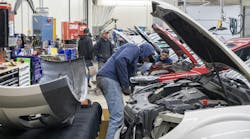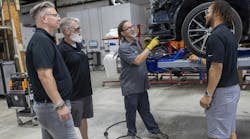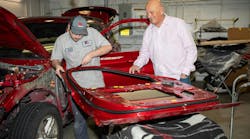At first glance, the state of the collision repair industry’s current workforce looks like a college kid’s bank account—there’s a lot more going out than there is coming in.
Recent TechForce Foundation data indicates that, this year, there’s a demand for 15,897 total new collision repair technicians in the U.S. alone. As a result, hiring has become quite the chore for body shop owners.
“We have this issue—the perfect storm,” explains Anne Bojko, a UTI official who oversees collision-repair employment for the school. “There’s a shortage of technicians, but the demand is rising at the same time because we have a good economy. The demand is rising, (but) there’s less students coming into the programs.”
Rob Stringer, the owner of Arizona Collision Center, has certainly felt that strain.
“There’s not a lot of new people coming into the industry,” says Stringer, a veteran of nearly two decades in collision repair. “Some of the hardest positions to fill are entry-level jobs, like lot attendant.”
Stringer, who runs a $3 million shop with a staff of 16, has noticed that many entry-level employees simply aren’t interested in slowly but surely climbing a shop’s staffing hierarchy.
“I tell people, ‘Chase opportunity, not money,’” he says.
Fortunately, Stringer and several other industry veterans have eventually found ways to overcome the obstacles often associated with the hiring process. And, they recently shared several such tips with FenderBender.
So, sit back, break out a highlighter, and let’s thumb through the hiring handbook for 2020.
Chapter 1: IDEAL JOB ADS
Job ads need to be worded carefully, or else they can result in a shop owner getting inundated with unqualified candidates.
With hastily written job ads on websites like Indeed.com, or Craigslist, Stringer notes, “a lot of the applicants aren’t as qualified as they pretend to be. I felt like I was just flooded with people that aren’t qualified for the position.”
Experts FenderBender spoke to for this article suggest keeping job ads concise, specifying the exact skills and training needed for the job opening, explaining the type of pay plan new hires will receive, and highlighting perks available to new hires (even fringe benefits such as not having to work evenings or Sundays). Even getting slightly creative with the wording of job titles can grab the attention of job applicants, such as referring to a technician as a “body repair expert.”
“Word the ads with the emotion (job candidates) are looking for: peace of mind, security,
hope for the future, longterm great earning potential,” says Dave Schedin, the CEO of CompuTrek Automotive Solutions. “If you’re a rural shop location attracting candidates from larger cities, you’ll need to create value words and reasonings for where your business is located, i.e. ‘family-friendly, great schools, little to no traffic or commute times.’”
Schedin also suggests noting incentive plans, typical per-year vacation ranges, and stating a pay range that top performers can expect to make at a shop.
“Everything needs to be geared toward bringing in an entry-level technician,” notes Bojko, whose employer, UTI, has three U.S. campuses with collision repair programs.
Today’s young, entry-level collision repairers expect to have all information about a potential employer laid out in front of them. That’s why Bojko suggests body shop owners provide transparency in the form of a detailed, one-page summary of their business to applicants.
“This generation is very different—they want to know everything,” the UTI official notes of today’s young adults. “They want to know every little detail. Like, what does it mean, 60 or 90 days (after hiring), if you’re exceeding expectations?”
Chapter 2: IDEAL INTERVIEW PROCESSES
These days, Ron Villard says, collision repair job candidates are a valued commodity on par with petroleum.
Great job candidates, he says, “are few and far between. So, they’re high-priced. You’re going to fight over them—you’re going to compete with your competitors over pricing.”
In an effort to avoid making a costly hiring mistake, then, Villard, the vice president of operations with southern California MSO 1st Certified Collision, has a refined interview process. The key steps include the following:
Have multiple managers conduct interviews.
1st Certified Collision, which has 10 locations and around 200 employees, typically has at least two managers lead interviews of job prospects. Often, three managers aid the process. It’s all in an effort to make sure candidates are asked every pertinent question possible before a hiring decision is made.
Once each manager has led their interview of a job candidate, Villard asks them for their impressions of the interviewee.
“Go through a tiered approach,” Villard suggests, “and maybe even have a human resources person do an interview, to make sure that this is going to be the right type of candidate for the company. … You want to pick the right candidate, so I use what I call ‘consensus-building.’”
Use working interviews when appropriate.
For entry-level positions like lot porter, Villard, now in his 29th year in collision repair, often brings candidates on-site for what effectively serves as a one-day tryout. He makes sure that working interview candidates, who typically work 6–8 hours alongside a veteran employee, are provided pay in the form of minimum wage (according to employeetestingcenter.com, job applicants taking part in working interviews must be compensated at no less than minimum wage, unless the work performed is de minimus, or “really minimum”).
“I’ve done that several times,” Villard says. “We’ll bring in a detailer, or even a porter, and check their skill set and see what they like to do.
“I have a production manager, or painter—whoever’s appropriate and available—oversee that person. Then I ask their opinion. I’m looking for focus, drive, energy, out-of-the-box thinking, and critical thinking. Are they making the right choices at the right time? For example, if I have a lobby full of customers and (the job candidate) starts emptying the garbage then, that’s not the best. You look at their behaviors.”
Ask probing questions.
Considering 1st Certified Collision repairs around 1,600 vehicles per month, Villard aims to make certain that the applicants he hires are in it for the long haul, are an ideal fit for his staff, and that they know what will be expected of them.
Thus, the hiring manager attempts to leave no stone unturned during the interview process, asking several questions during casual, extended sit-down interviews. The key interview questions, Villard says, are the following:
“Where do you see yourself 5 years from now?”
“What, exactly, are you looking for out of the job?”
“Are you a hands-on individual, or more comfortable at a desk?”
Questions such as those, Villard notes, “tell me whether I’m going to be able to invest my time and make a longterm investment (in the candidate). The auto body industry is a different type of beast, and you can gauge who’s going to stay and who’s not just through casual conversation.
“I’m looking for somebody who’s saying ‘I want to earn my way through this business; what’s it going to take for me to get there?’”
Chapter 3: OFFER ESSENTIAL BENEFITS
Gone are the days in which shop owners could get away with neglecting to offer benefits. Making that decision in 2020 would leave a shop struggling to outfight competitors for top talent.
After all, consolidators like Caliber and Service King, buoyed by their strength in numbers, are offering fairly extensive benefits packages these days, Stringer notes. Most young technicians and painters now expect core benefits like health insurance, vision, dental, 401(k) and short-term disability from their employer.
Baca, the collision repair instructor at Luna Community College, says his students tend to place an especially high importance on health insurance. And Villard, the hiring manager with 1st Certified Collision, adds, “To be competitive, the big thing these days is 401(k). Everyone’s offering the medical benefits, (so) 401(k) is it.”
Peripheral “benefits” or perks can often be effective in luring quality job candidates, too. For example, officials at UTI have seen recent students seek tuition-reimbursement packages from employers. Those types of packages (even those paying as little as $200 per month) help with retention more than sign-on bonuses, and they offer an immediate incentive for young adults who aren’t yet focused on long-term benefits, explains Cindy Kostelac, a hiring incentive team member with UTI.
“Tuition reimbursement needs to be factored as the cost of doing business,” Kostelac says. “I tell employers these expenses should be handled like any other employer benefit. The top example I use is that most employers today offer 401(k) as a benefit; a newly graduated student with student loans looming more than likely can’t contribute to that type of benefit that rewards them much later in life. Rather, have something in place that they can take advantage of in the early stages of their career, when they’ll be making lower wages.”
UTI officials say they’ve witnessed perks like tuition-reimbursement plans be an extremely successful approach for employers. And, after all, it’s more expensive to train a string of new employees than it is to keep a young worker with potential.
While some shop owners struggle to meet job candidates’ demands in 2020, modern entry-level workers aren’t all that different from previous generations. More than anything, they simply want to feel like they’re going to be appreciated by the shop owner that eventually hires them.
“What they want more than anything,” Stringer says of entry-level collision repairers, “is a team atmosphere. They want something they can believe in.”



